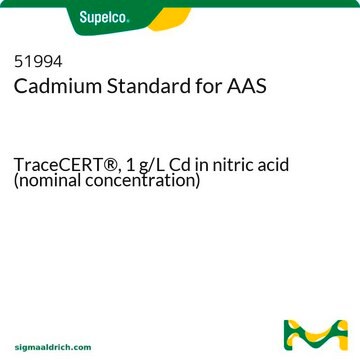If this product has an expiration or retest date, it will be shown on the Certificate of Analysis (COA, CofA). If there is no retest or expiration date listed on the product's COA, we do not have suitable stability data to determine a shelf life. For these products, the only date on the COA will be the release date; a retest, expiration, or use-by-date will not be displayed.
For all products, we recommend handling per defined conditions as printed in our product literature and website product descriptions. We recommend that products should be routinely inspected by customers to ensure they perform as expected.
For products without retest or expiration dates, our standard warranty of 1 year from the date of shipment is applicable.
For more information, please refer to the Product Dating Information document: https://www.sigmaaldrich.com/deepweb/assets/sigmaaldrich/marketing/global/documents/449/386/product-dating-information-mk.pdf
270393
Tetrachloroethylene
suitable for HPLC, ≥99.9%
Synonyme(s) :
PCE
Sélectionner une taille de conditionnement
114,00 $
Sélectionner une taille de conditionnement
About This Item
114,00 $
Produits recommandés
Qualité
HPLC grade
Densité de vapeur
5.83 (vs air)
Pression de vapeur
13 mmHg ( 20 °C)
19 mmHg ( 25 °C)
Essai
≥99.9%
Forme
liquid
Produit purifié par
glass distillation
Technique(s)
HPLC: suitable
Impuretés
<0.050% water
Résidus d'évap.
<0.0005%
Couleur
APHA: ≤10
Indice de réfraction
n20/D 1.505 (lit.)
pb
121 °C (lit.)
Pf
−22 °C (lit.)
Densité
1.623 g/mL at 25 °C (lit.)
λ
H2O reference
Absorption UV
λ: 290 nm Amax: 1.00
λ: 295 nm Amax: 0.30
λ: 300 nm Amax: ≤0.20
λ: 305 nm Amax: 0.10
λ: 350 nm Amax: 0.05
λ: 400 nm Amax: 0.03
Application(s)
food and beverages
Chaîne SMILES
Cl\C(Cl)=C(\Cl)Cl
InChI
1S/C2Cl4/c3-1(4)2(5)6
Clé InChI
CYTYCFOTNPOANT-UHFFFAOYSA-N
Vous recherchez des produits similaires ? Visite Guide de comparaison des produits
Catégories apparentées
Application
- Dispersive liquid-liquid microextraction as a novel enrichment approach for compound-specific carbon isotope analysis of chlorinated phenols.: This study introduces a novel microextraction technique involving tetrachloroethylene, enhancing the sensitivity and specificity of carbon isotope analysis in complex environmental samples (Martin et al., 2024).
- Photo-on-Demand In Situ One-Pot Synthesis of Carbonate Esters from Tetrachloroethylene.: This research presents a novel photochemical method for synthesizing carbonate esters from tetrachloroethylene, demonstrating its potential in synthetic organic chemistry and industrial applications (Higashimura et al., 2024).
Mention d'avertissement
Warning
Mentions de danger
Conseils de prudence
Classification des risques
Aquatic Chronic 2 - Carc. 2 - Eye Irrit. 2 - Skin Irrit. 2 - Skin Sens. 1 - STOT SE 3
Organes cibles
Central nervous system
Code de la classe de stockage
6.1C - Combustible acute toxic Cat.3 / toxic compounds or compounds which causing chronic effects
Classe de danger pour l'eau (WGK)
WGK 3
Point d'éclair (°F)
No data available
Point d'éclair (°C)
No data available
Faites votre choix parmi les versions les plus récentes :
Déjà en possession de ce produit ?
Retrouvez la documentation relative aux produits que vous avez récemment achetés dans la Bibliothèque de documents.
Les clients ont également consulté
-
How can I determine the shelf life / expiration / retest date of this product?
1 answer-
Helpful?
-
-
How is shipping temperature determined? And how is it related to the product storage temperature?
1 answer-
Products may be shipped at a different temperature than the recommended long-term storage temperature. If the product quality is sensitive to short-term exposure to conditions other than the recommended long-term storage, it will be shipped on wet or dry-ice. If the product quality is NOT affected by short-term exposure to conditions other than the recommended long-term storage, it will be shipped at ambient temperature. As shipping routes are configured for minimum transit times, shipping at ambient temperature helps control shipping costs for our customers. For more information, please refer to the Storage and Transport Conditions document: https://www.sigmaaldrich.com/deepweb/assets/sigmaaldrich/marketing/global/documents/316/622/storage-transport-conditions-mk.pdf
Helpful?
-
Active Filters
Notre équipe de scientifiques dispose d'une expérience dans tous les secteurs de la recherche, notamment en sciences de la vie, science des matériaux, synthèse chimique, chromatographie, analyse et dans de nombreux autres domaines..
Contacter notre Service technique











